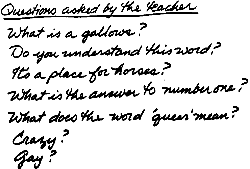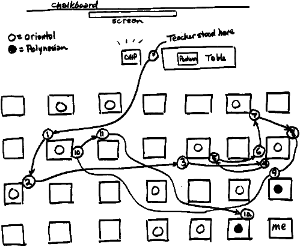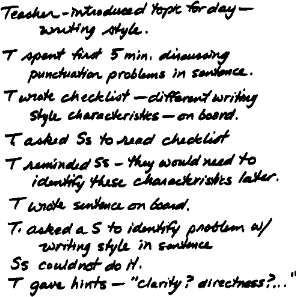Basic
Procedure
1. Begin with a
desire to be an even better teacher.
2. Realize that
working alone you may not have a full, accurate
perspective on yourself and your own teaching.
3. Invite a
trusted a colleague to observe your teaching and then
share data.
4. Before the
observation, discuss which of the following techniques
would be best for you at this time. (Each has a different
purpose. The choice depends on the type of information
that will be most useful to you.)
5. After the
observation is done (and class is over), meet with the
observer and discuss the data gathered.
6. Use this data
as the basis for understanding and making decisions about
your teaching.
Purpose:
Determine what teachers and students say to each other
and how they say it.
Procedure:
In pre-observation conference, select an aspect of
classroom discourse to focus on (e.g., teacher questions,
student responses, etc.). Observer writes down
word-for-word only those aspects of classroom discourse.

Purpose:
Find out who is partcipating in class and who is not by
determining who says things and to whom.
Procedure:
Teacher (or observer) prepares seating chart of class in
advance. Each student is represented by a box with
his/her name. The teacher (T in a circle) is at the top
of the chart. Observer draws an arrow on the chart every
time someone in the class asks a question or gives an
answer.
Purpose:
Determine whether students are paying attention or doing
what the teacher assigned (and which students are and are
not) by noting which kinds of behaviors are actually
happening.
Procedure:
Teacher (or observer) prepares seating chart of class in
advance. Each student is represented by a box with
his/her name. Down the side of the box are numbers (one
for each "sweep" of the class, up to 20). There
is an empty box at the top of the chart for noting the
beginning time of each sweep.
Purpose:
Track the path of the teacher's movement around the
classroom and discover which and how many students he/she
interacts with (and which students are ignored).
(Note: Especially suited to classrooms where there is a
lot of teacher movement, e.g. information gap activities
with pairs. )
Procedure:
Teacher (or observer) prepares a rough map of the class
in advance. As the teacher moves around the room, the
observer draws in arrows to indicate this movement.
Whenever the teacher stops to interact with a student,
the observer draws a circle at that spot and writes a
number in it to show the sequence.
(Note: It is possible to track students also.)

Purpose:
Discover patterns of teacher behavior and speech (e.g.,
lecturing, questioning, responding.)
Warning: This can become quite complicated!
Procedure:
In a pre-observation conference, teacher and observer
produce a category system appropriate to the teacher's
style and concerns and what the teacher and students will
be doing on the day of the observation.
For
instance,
F = Expressing feelings
P = Giving praise
E = Giving encouragement
L = Lecturing
D = Giving directions
C = Criticizing
Q = Questioning
I = Sharing an idea
U = Using (an idea)
R = Restating a previously expressed idea
Caution:
Don't use the same letter for two different categories.
Upper-case
letters are used for the teacher; lower case for the
students. For example:
Q r Q i U i E i E
Time
(hour and minute) can also be added to the sequence.
(9:15) Q r Q i U(9:16) i E i E (9:17)
These
data can also be graphed like this:

To
add a third dimension to the data, notations can be made
on a seating chart. That way the data will show who did
what types of interacting.
Purpose:
Get the "big picture" (to determine needs for
future observations)
Procedure:
Using a "wide lens" without any particular
focus, the observer records "everything" (of
interest) that happens. He/she uses an anecdotal approach
(short, descriptive sentences) to document classroom
events. He/she tries to remain as objective as possible
(e.g., "Mike is out of his seat. John is
talking." not "This class is out of
control!").

|